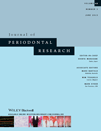The role of physiological markers of health in the association between demographic factors and periodontal disease
Abstract
Background and Objective
Age is highly related to oral health status. The higher prevalence of oral disease within subgroups of the population may reflect a tendency towards “early aging” and dysregulation of multiple physiological systems. This study examines whether the association between periodontal disease and demographic factors is mediated by physiological measures of health.
Material and Methods
Logistic regression was used to examine whether biomarkers and demographic factors, such as socio-economic status (SES) and race/ethnicity, were associated with periodontal disease, and then whether the strength of these relationships could be attributed to associations between demographic variables and physiological measures of systemic health.
Results
Periodontal disease was associated with measures of SES and race/ethnicity. Furthermore, 1-unit increases in cytomegalovirus (CMV), optical density, C-reactive protein (CRP) and glycated hemoglobin (HbA1c) were associated with a 25% [odds ratio (OR) = 1.25; 95% confidence interval (CI): 1.14–1.36], 13% (OR = 1.13; 95% CI = 1.03–1.24) and 19% (OR = 1.19; 95% CI = 1.12–1.27) increased likelihood of periodontal disease, respectively. However, when biomarkers and socio-demographic variables were both included in the model, their associations with periodontal disease were significantly reduced or eliminated.
Conclusions
The risk of periodontal disease is higher among black and/or low-income individuals; however, these associations appear to be partly due to the greater probability of elevated levels of CRP, CMV or HbA1c among these groups.




